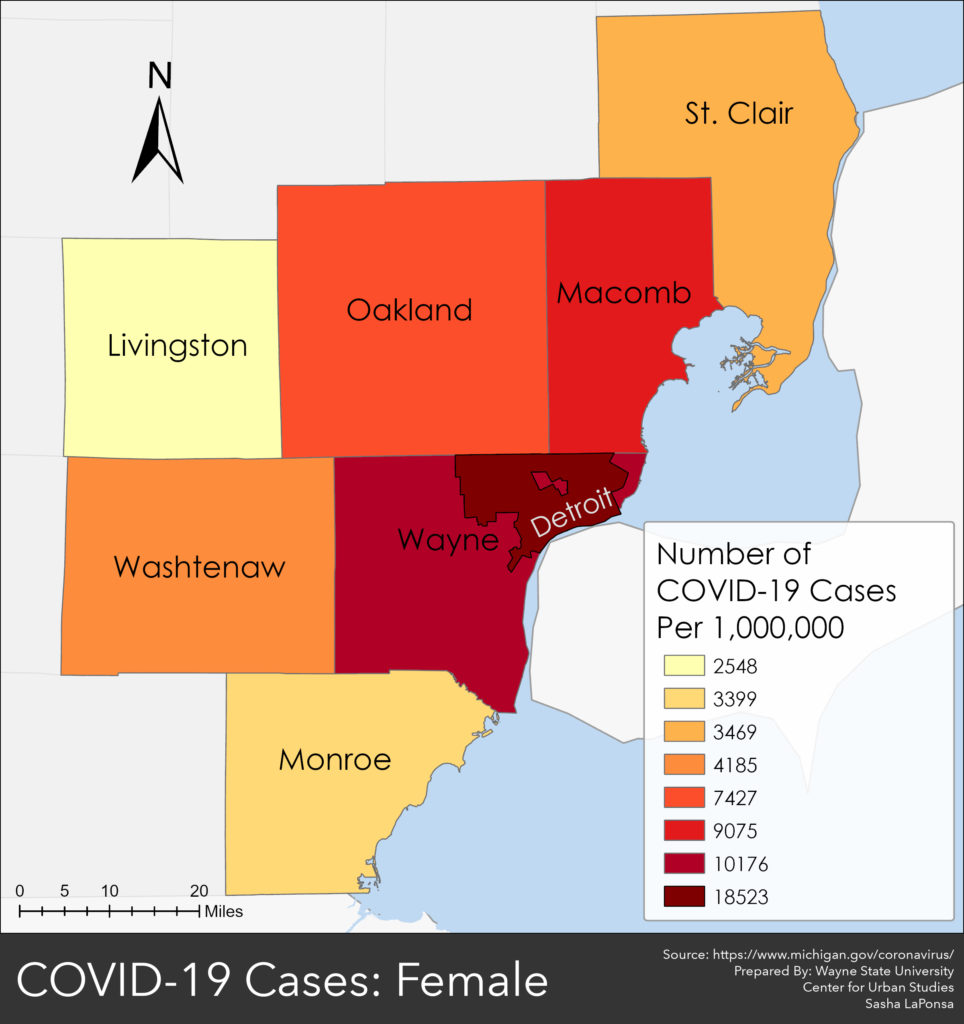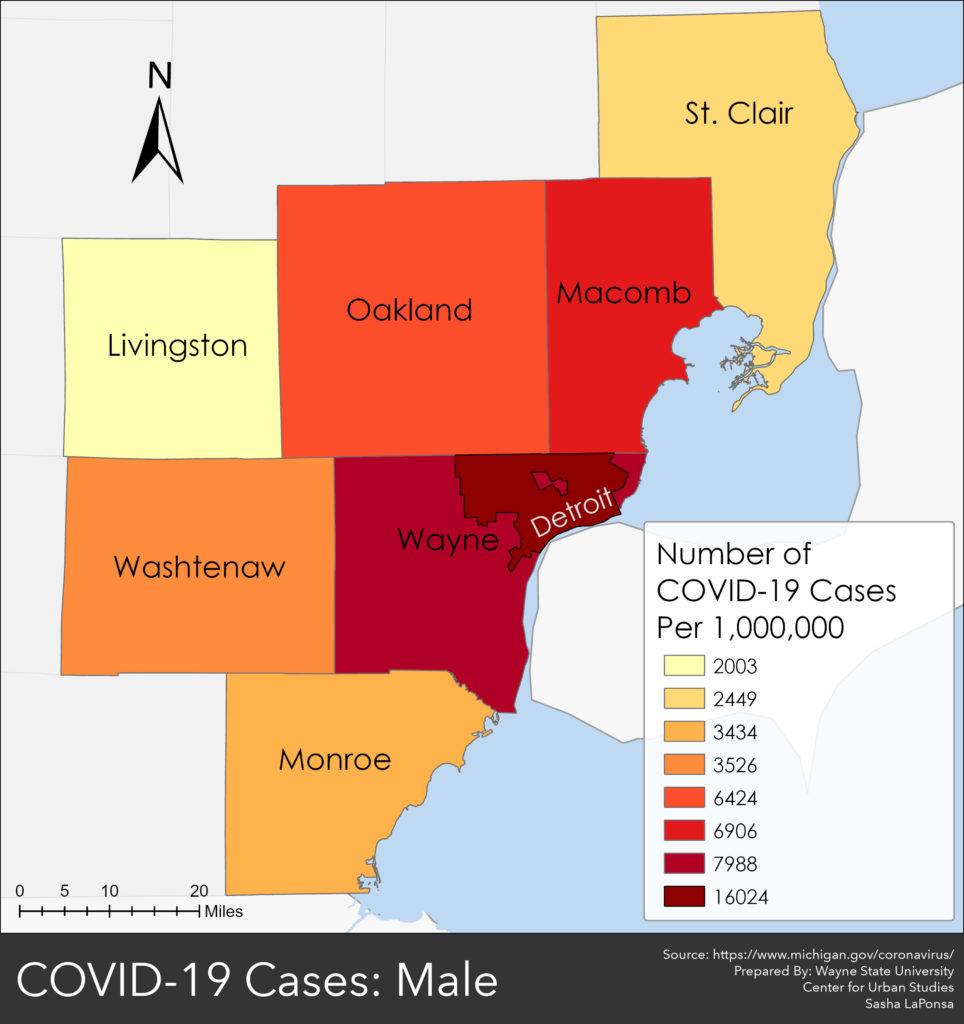In the State of Michigan females are testing positive for coronavirus at a higher rate than males, according to the data from the Michigan Department of Health and Human Services. As of July 5, 65,876 COVID cases were reported Statewide, and of those 34,387–or 52 percent–were reported in the female population. In the maps below, we show the number of COVID cases per million by county and the City of Detroit in Southeastern Michigan for both the female and male populations. While the maps reflect data from late June they still highlight trends of areas that are being hit harder than others; this post simply narrows in on that through a gender lens.
The first map above shows that the City of Detroit had the highest per capita rate for the number of females who tested positive for COVID. According to the data, there were 18,523 females per million who tested positive. This was the highest per capita rate in the region. As of July 5 there were 6,518 females who tested positive in Detroit. The second map above shows that, on a per capita basis, Detroit also had the highest rate of males testing positive for COVID. According to the data, there were 16,024 males per million people in the City of Detroit who tested positive for COVID in late June. As of July 5, there were 5,117 males in Detroit who tested positive. In Detroit, females are testing positive for COVID at a rate 1.2 times higher than males. Overall, the City of Detroit had 11,709 cumulative positive COVID cases on July 5.
Wayne County had the second highest per capita rate of females and males who tested positive for COVID. According to the data there were 10,176 females per million who tested positive and 7,988 males per million who tested positive. On July 5, there were 6,009 females who tested positive for COVID in Wayne County and 4,495 males; females are testing positive for COVID at a rate 1.3 times higher than males.
Livingston County had the lowest per capita rates of both females and males affected by COVID; it also has the lowest numbers of individuals who have tested positive for the virus. According to the data, Livingston County had 2,548 females per million who tested positive for COVID; as of July 5 there were 260 total females who tested positive. For the male population in Livingston County, there were 2,003 per million who tested positive. On July 5 there were 214 total males in Livingston County who tested positive for COVID. Females are testing positive for COVID at a rate 1.2 times higher than males in Livingston County. Overall, there were 473 cumulative COVID cases reported in Livingston County on July 5.
As noted above, this post was intended to show the gender distribution of COVID in Southeastern Michigan. And, while the data does show women are testing positive for COVID at a higher rate than males, this post also further highlights how the City of Detroit is being affected by the virus at a higher rate than other areas in the State no matter what way you look at the data.
While per capita rates are used as a statistical measurement to show how certain indicators or events are affecting various places despite the varying population numbers, we know that Detroit has the highest number of cases at the municipal level statewide. We also know, as shown in our last post, that the black population is being disproportionately affected by COVID and the City of Detroit has the highest black population in the State.


The first map above shows that the City of Detroit, cumulatively, had the highest per capita rate for the number of females who tested positive for COVID. According to the data 18,523 females per million had tested positive. This was the highest per capita rate in the region. As of July 5 6,518 females had tested positive in Detroit. The second map above shows that, on a per capita basis, Detroit also had the highest rate of males testing positive for COVID. According to the data, there were 16,024 males per million people in the City of Detroit who tested positive for COVID in late June. As of July 5, there were 5,117 males in Detroit who tested positive. In Detroit, females are testing positive for COVID at a rate 1.2 times higher than males. Overall, the City of Detroit had 11,709 cumulative positive COVID cases on July 5.
Wayne County had the second highest per capita rate of females and males who tested positive for COVID. According to the data there were 10,176 females per million who tested positive and 7,988 males per million who tested positive. On July 5, there had been 6,009 females who tested positive for COVID in Wayne County and 4,495 males; females are testing positive for COVID at a rate 1.3 times higher than males.
Livingston County had the lowest per capita rates of both females and males affected by COVID; it also has the lowest numbers of individuals who have tested positive for the virus. According to the data, Livingston County had 2,548 females per million who tested positive for COVID; as of July 5 there were 260 total females who tested positive. For the male population in Livingston County, there were 2,003 per million who tested positive. On July 5 there were 214 total males in Livingston County who tested positive for COVID. Females are testing positive for COVID at a rate 1.2 times higher than males in Livingston County. Overall, there were 473 cumulative COVID cases reported in Livingston County on July 5.
As noted above, this post was intended to show the gender distribution of COVID in Southeastern Michigan. And, while the data does show women are testing positive for COVID at a higher rate than males, this post also further highlights how the City of Detroit is being affected by the virus at a higher rate than other areas in the State no matter what way you look at the data. While per capita rates are used as a statistical measurement to show how certain indicators or events are affecting various places despite the varying population numbers, we know that Detroit has the highest number of cases at the municipal level statewide. We also know, as shown in our last post, that the black population is being disproportionately affected by COVID and the City of Detroit has the highest black